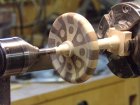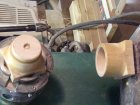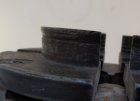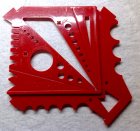The recent thread that included suggestions on chuck size and the advantages of smaller diameter chucks reminded me of something I learned earlier this year about desirable tenon diameter. Rather than poach the other thread, I thought I'd share the observation separately, for whatever it is worth.
While looking back on the bowls I've made over the last couple of years, I became dismayed at how many of them have a just a little too big diameter bottom. (Ironically, I just purchased a copy of Richard Raffan's "Turned Bowl Design", and he shows exactly this in a couple of pictures.) This is a common experience when looking back at our earliest work, but I should know better. And I do, so I pondered what had happened.
The light bulb went on when I realized that after a learning session on coring, I decided I would have more secure mountings with larger diameter jaws. As a result, the base of the bowl also increased a little in diameter and I'm not good at seeing the true shape/form while the wood is horizontal on the lathe.
I've been trying to reshape the base when the bowl is reversed to take off the tenon, but as a result of the experienced comments on chuck diameter in the other thread, I'm going to downsize my jaw size when possible. So, not only is chuck diameter important, the diameter of the jaws is quite important to the success of the piece.
On a related note, I've always been a fan of dovetailed jaws, thinking the shape would pull the tenon snugly into the chuck. In spite of being fanatical about making well shaped and clean tenons, I still break one off from time to time, usually at about the midpoint when turning green blanks. I'm reconsidering whether straight jaws might be more secure after all, and the tenons are certainly easier to form.
While looking back on the bowls I've made over the last couple of years, I became dismayed at how many of them have a just a little too big diameter bottom. (Ironically, I just purchased a copy of Richard Raffan's "Turned Bowl Design", and he shows exactly this in a couple of pictures.) This is a common experience when looking back at our earliest work, but I should know better. And I do, so I pondered what had happened.
The light bulb went on when I realized that after a learning session on coring, I decided I would have more secure mountings with larger diameter jaws. As a result, the base of the bowl also increased a little in diameter and I'm not good at seeing the true shape/form while the wood is horizontal on the lathe.
I've been trying to reshape the base when the bowl is reversed to take off the tenon, but as a result of the experienced comments on chuck diameter in the other thread, I'm going to downsize my jaw size when possible. So, not only is chuck diameter important, the diameter of the jaws is quite important to the success of the piece.
On a related note, I've always been a fan of dovetailed jaws, thinking the shape would pull the tenon snugly into the chuck. In spite of being fanatical about making well shaped and clean tenons, I still break one off from time to time, usually at about the midpoint when turning green blanks. I'm reconsidering whether straight jaws might be more secure after all, and the tenons are certainly easier to form.





